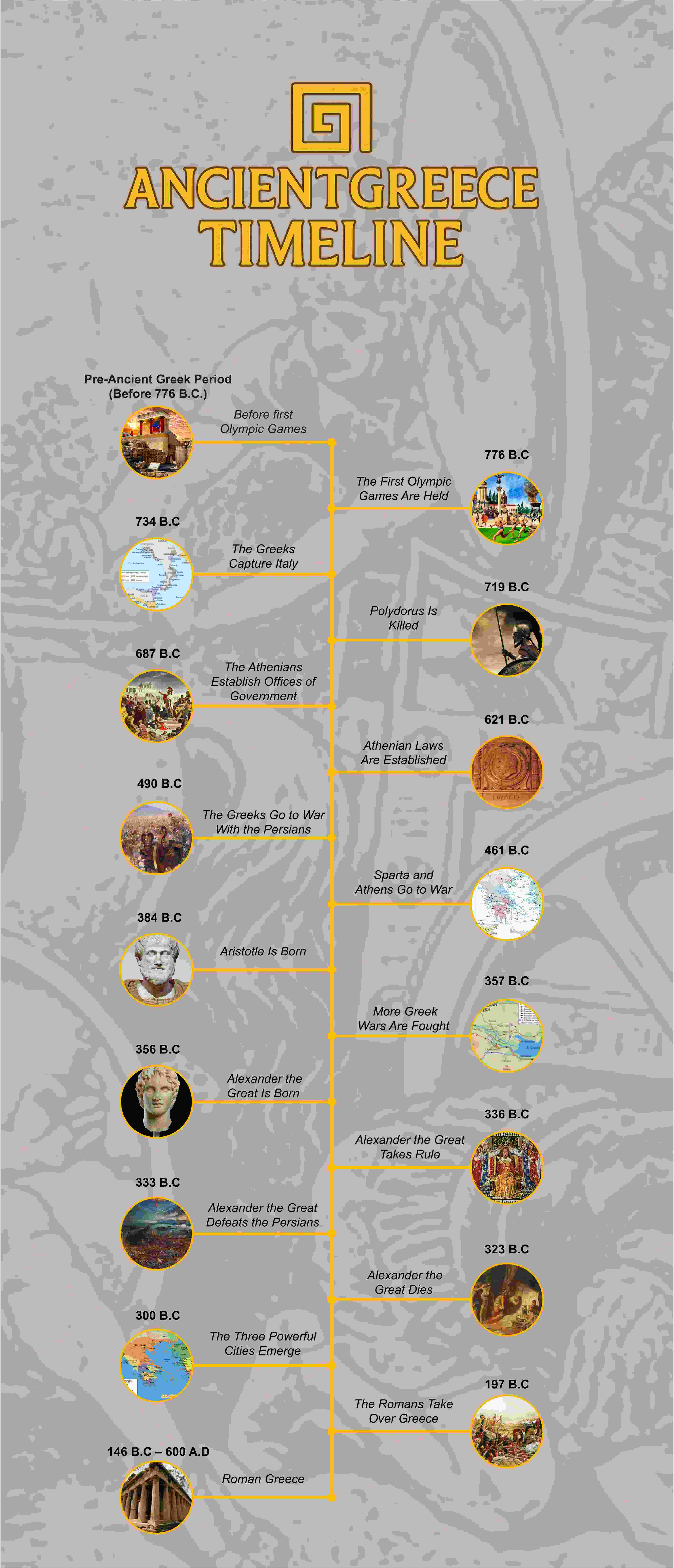If you think today’s world is clever, wait until you hear about Ancient Greece. This is where so many great ideas were born. Democracy. Philosophy. Theater. Even the Olympic Games.
Ancient Greece was full of life. Markets buzzed with traders. Temples rose high above the cities. Athletes competed for glory. Each city-state ruled in its own way. Athens loved debates and voting. Sparta trained warriors from childhood.
It all began with small villages. Over time, Greece became a culture that shaped the Mediterranean. In this timeline, we’ll explore their story, and see why it still inspires us today.
In this article
Timeline of Ancient Greece
Greek history is split into three main periods. The Archaic Period (800–490 BCE) was the start. This is when city-states like Athens and Sparta began to grow. Art, trade, and early laws took shape.
The Classical Period (490–323 BCE) brought big changes. Athens created new democratic ideas. There were famous wars like the Persian and Peloponnesian Wars. This era also saw the rise of Alexander the Great. After his death, the Hellenistic Period (323–146 BCE) began. Greece slowly lost power. In 146 BCE, Rome took control.
Now, let's explore the key events that made each period unforgettable.
Pre-Ancient Greek Period (Before 776 B.C.)
Before ancient Greece, other civilizations ruled the land. The Minoans on Crete built huge palaces and traded across the seas. Then came the Mycenaeans with strong kings and grand fortresses. They loved myths of gods and heroes.
After their fall, Greece entered a "Dark Age." Cities became small. Writing disappeared. People lived simple lives in small villages. Slowly, they grew again. These humble beginnings set the stage for the rise of ancient Greece.
776 B.C
In Olympia, athletes from different city-states gathered to honor Zeus. The first Olympic Games brought people together in peace. They competed in foot races, wrestling, and chariot racing. Winners were crowned with olive wreaths.
The games became a tradition every four years. City rivalries paused for the event. It was more than sport, it was a celebration of unity. These games later inspired the modern Olympics we know today. A simple race began a lasting legacy.
734 B.C
King Polydorus of Sparta sent his warriors west across the sea. They landed in southern Italy and claimed new land. The Greeks built cities with temples, theaters, and marketplaces. Greek culture began to grow far from home.
This region became known as "Magna Graecia," or "Greater Greece." It looked and felt like Greece itself. Greek art, language, and customs spread across the area. A single voyage changed Italy's history and brought Greek ideas into a new world.
719 B.C
Polydorus, the king of Sparta, was murdered by a man named Polymarchus. The reasons are unclear, but jealousy and politics likely played a part. In ancient Greece, leadership often came with danger.
Powerful rulers gained enemies quickly. Betrayal was common in the struggle for control. The death of Polydorus was a dark moment for Sparta. It showed how fragile power could be, even for a king with an army behind him.
687 B.C
Athens took a bold step toward democracy. They created official positions so citizens could help lead. The top leader was called the Archon. For the first time, power was shared beyond the nobility.
This change gave ordinary people a voice in government. Decisions were no longer made by a few powerful families. It wasn't full democracy yet, but it was the first step. Athens began building a system that would influence politics for centuries.
621 B.C
Athens had always followed unwritten rules. Then Draco, a lawmaker, created the first written code. Now crimes and punishments were clear for everyone to see. But the laws were extremely harsh, with even small crimes punished by death.
The people thought Draco's rules were too cruel. Still, they marked the beginning of written law in Athens. Later leaders would make fairer systems. Draco's code taught the Athenians that justice needed to be strong, but also balanced.
490 B.C
The Persian Empire tried to conquer Greece. At Marathon, the Greek city-states stood together and fought fiercely. Using clever tactics, they defeated the much larger Persian army.
A runner carried news of the victory to Athens, inspiring the word "marathon" we use today. This win proved that even small, united forces could overcome mighty empires. It was a moment of courage and strategy that shaped Greece's reputation as a powerful defender of freedom.
461 B.C
Former allies Sparta and Athens became bitter enemies. The Peloponnesian War began and lasted nearly three decades. The two cities had very different views. Athens loved democracy, while Sparta preferred rule by the few.
The fighting was fierce on both land and sea. In the end, Sparta won. But both sides were left weaker than before. This long war opened the door for other powers to rise in Greece, changing the balance of control forever.
384 B.C
Aristotle was born in Stagira, a small Greek town. He grew into one of the greatest thinkers in history. He studied under the famous philosopher Plato and later taught Alexander the Great.
Aristotle explored questions about life, science, and ethics. His writings influenced schools, governments, and leaders for centuries. Even today, his ideas are studied around the world. From a humble birthplace, he became a mind that helped shape the way humans think.
357 B.C
After Athens and Sparta ended their long war, a new power threatened Greece Macedon. King Philip II led strong armies and used clever strategies to take control.
The Greek city-states were divided and couldn't unite against him. One by one, they lost independence. This marked the end of free city-states in Greece. A single powerful kingdom now ruled the land, setting the stage for one of history's most famous leaders.
356 B.C
Alexander was born in Macedon to King Philip II. His teacher was Aristotle, who encouraged his love of learning and exploration. Even as a boy, Alexander showed courage and ambition.
No one could guess how far he would go. He dreamed of conquering the world and spreading Greek culture. His name would one day be known across continents. The birth of Alexander marked the beginning of an extraordinary story in history.
336 B.C
When King Philip II was assassinated, Alexander became king at just 20 years old. Despite his youth, he was ready to lead and quickly earned the trust of his people.
He united the Greek city-states and prepared to attack Persia. With brilliant strategies and fearless leadership, Alexander began his campaign. This was the start of an empire that would stretch farther than any Greece had seen before, changing the ancient world forever.
333 B.C
Alexander marched into Persian territory and won decisive victories. He took control of Mesopotamia and Egypt, lands once ruled by powerful Persian kings. His battles were fast, bold, and successful.
The defeat of Persia marked the rise of a new age led by Greek ideas. Alexander's empire stretched from Greece to India. He became a legend in his own lifetime, spreading language, culture, and innovation far beyond his homeland.
323 B.C
At only 32 years old, Alexander died in Babylon. Some believe it was illness; others suspect poison. His sudden death shocked the ancient world.
Without a clear heir, his vast empire quickly broke apart. His generals took pieces for themselves. The dream of a united empire faded, but Alexander's influence remained. His conquests had spread Greek culture across continents, leaving a legacy that lasted for centuries.
300 B.C
After Alexander's death, his empire split into three main kingdoms. Macedon ruled in Greece, Egypt was led by Ptolemy, and Syria was controlled by Seleucus. All three rulers had been Alexander's generals.
These kingdoms often fought each other, but they also worked to preserve Greek culture. They built cities, supported art, and spread ideas. Even without one ruler, Greek influence stayed strong across the Mediterranean and beyond.
197 B.C
Rome grew powerful while Greece grew weaker. King Philip V of Macedon challenged Rome but lost. This defeat marked the beginning of Roman control in Greece.
Although Greece lost independence, its culture did not fade. The Romans admired Greek art, literature, and philosophy. They adopted much of it into their own society. In many ways, Greek influence grew even stronger under Roman rule.
146 B.C - 600 A.D
In 146 B.C., Greece became fully part of the Roman Empire. Greek culture blended with Roman traditions. Greek teachers taught Roman students, and Greek theaters continued to hold plays.
Even as political power rested with Rome, the Greek spirit remained strong. The eastern Roman Empire became mostly Greek in language and culture. For centuries, Greece continued to shape art, science, and thought, proving its influence could outlast even the mightiest empires.
How to Make a Similar Timeline in EdrawMax?
The history of Ancient Greece covers hundreds of years. It's easy to get lost in all the dates and events. A timeline puts everything in order so it's simple to follow. With EdrawMax, a wonderful timeline software, you can make a neat, organized timeline in just a few steps. Here's how to start.
Step 1
- First, download and install EdrawMax on your device.
- Open it and sign in with your Wondershare ID or a linked account.
- On the left side, click Home. At the top blue bar, choose Basic Diagram.
- From the list, click Timeline to see ready-made designs.
- You can also type "timeline" in the search box to find them quickly.
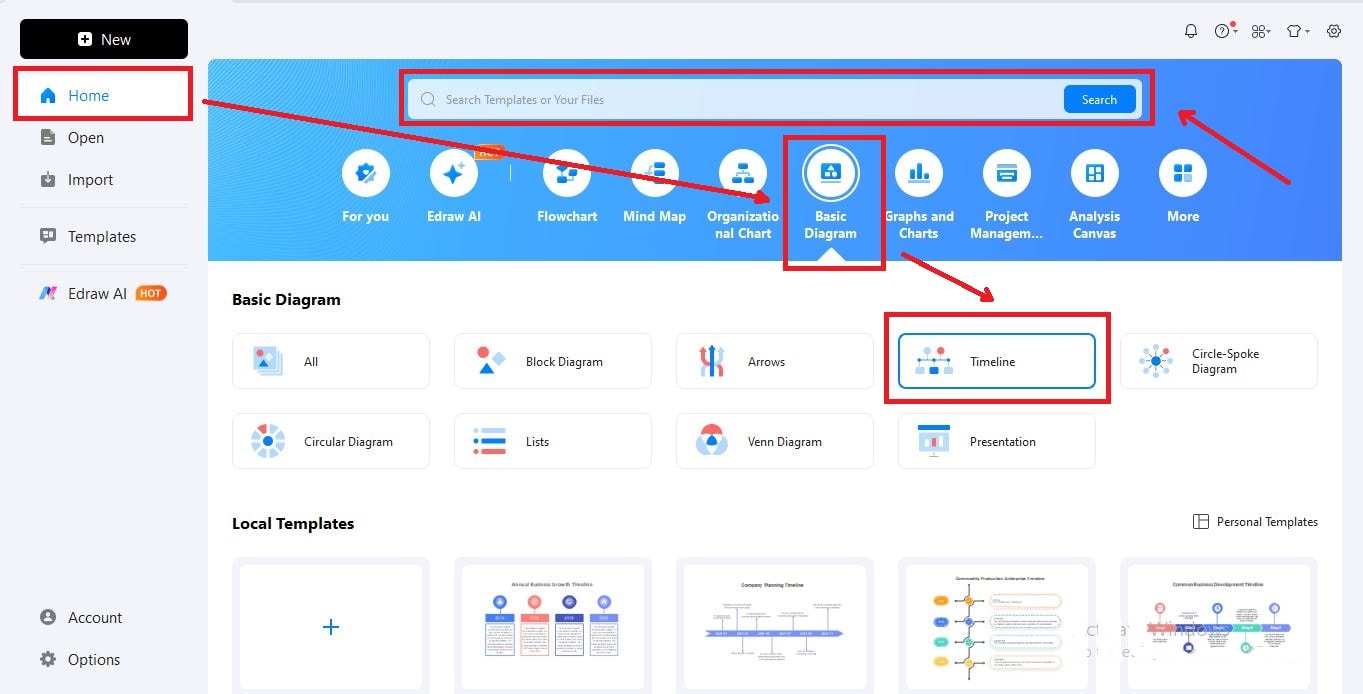
Step 2
- In Local Templates, explore different styles, or click scroll more templates if you didn't find your desired one.
- Pick one that suits your Ancient Greece project, or click Blank Drawing to start from scratch.
- Double-click your selection or click Use Immediately to begin editing.
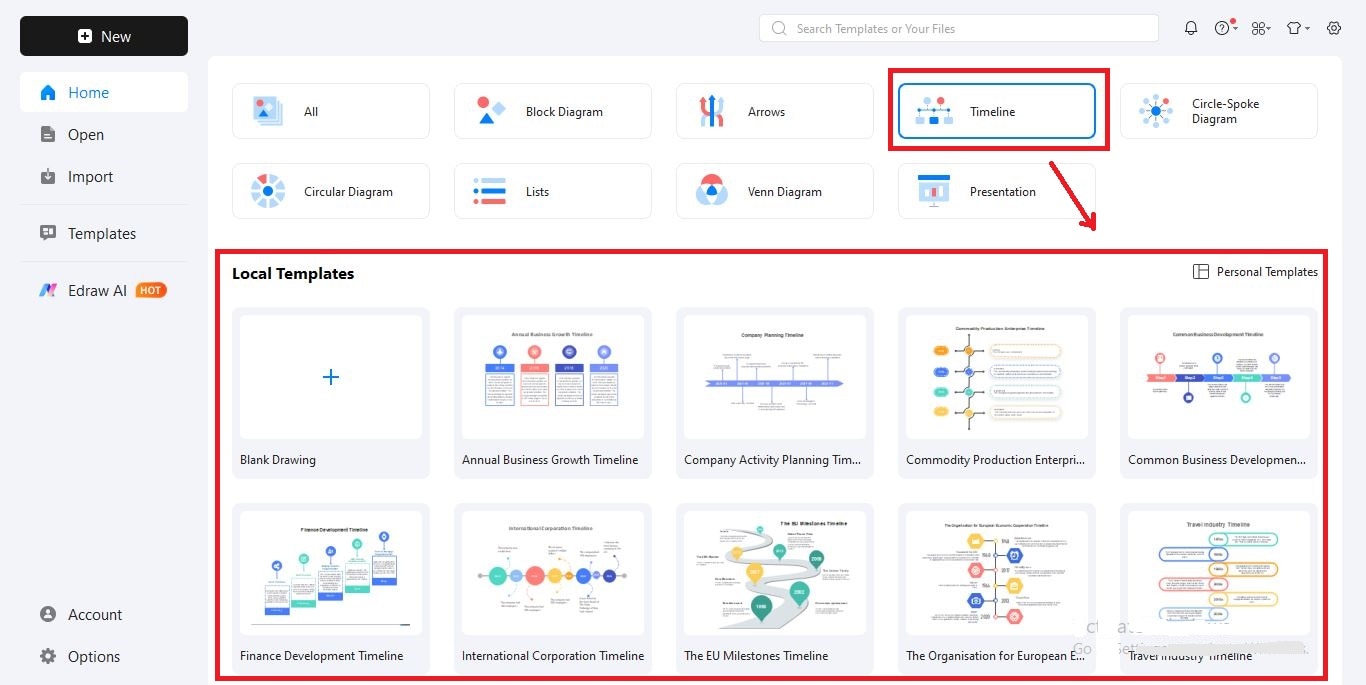
Step 3
- Go to the Home tab and click Text to add a title, like "Ancient Greece Timeline."
- To change the sample events, click the text on the timeline and replace it with your own dates and descriptions, such as "776 BCE: First Olympic Games."
- You can double-click any text to edit and use the small floating menu to change font, size, color, or alignment.
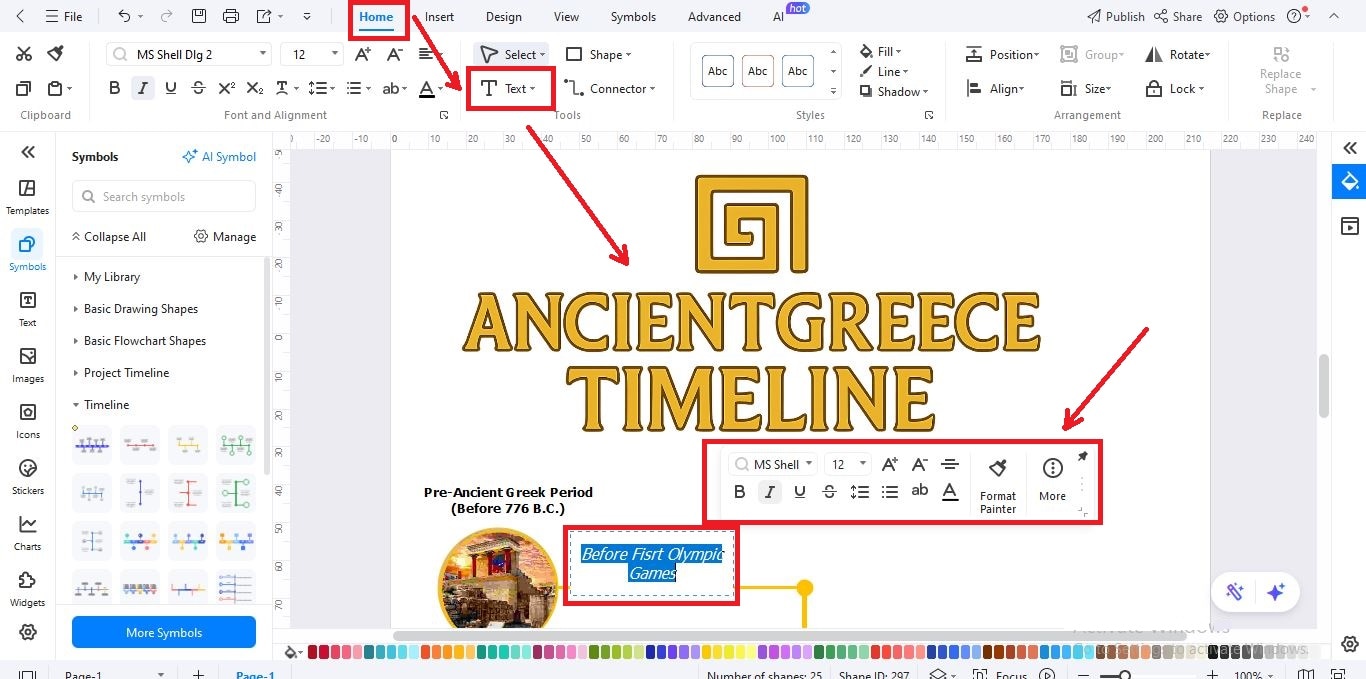
Step 4
In the Home tab use:
- Select to move things around.
- Text to add more labels.
- Shape to add boxes or callouts for key events.
- Connector to draw lines linking events.
- You can also add pictures, symbols, icons, stickers, or charts from the left side to make your timeline more interesting.
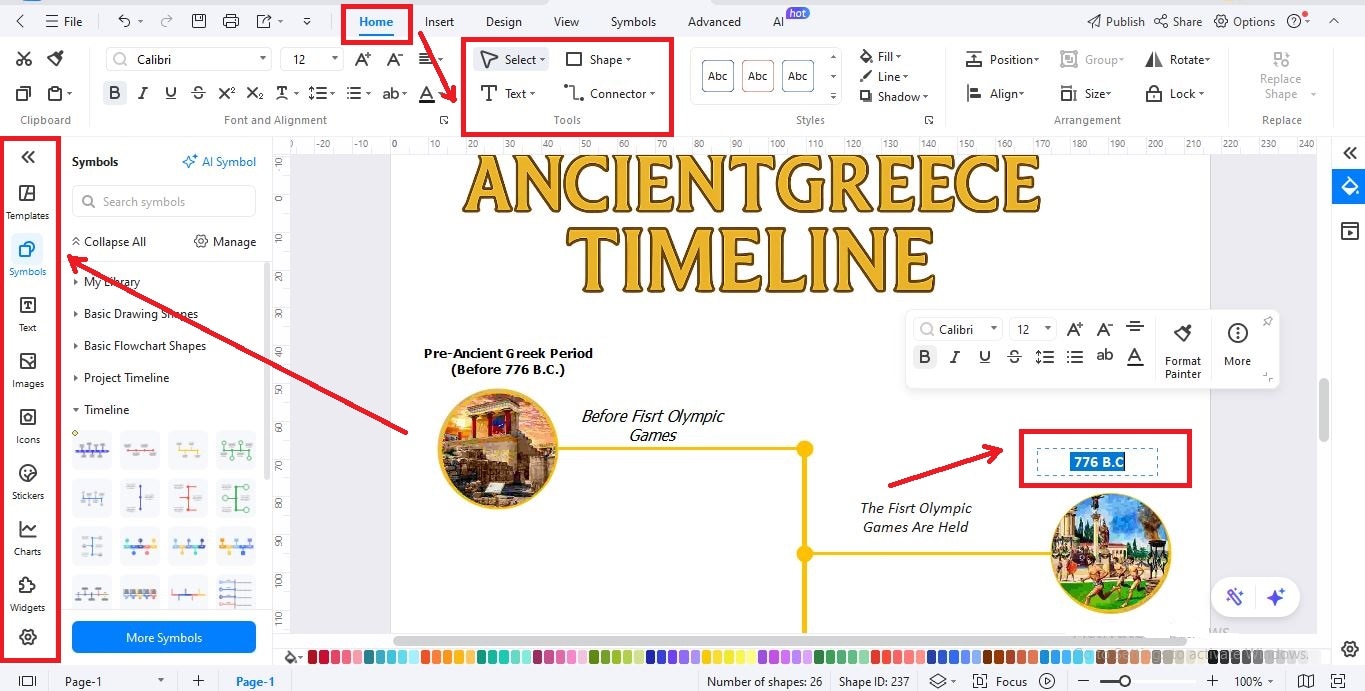
Step 5
- Click on any object to change how it looks. In the Styles toolbar, you can change the fill color, outline, or shadow.
- Use the bottom color bar to add colors that match the Ancient Greece theme, like white, gold, or blue.
- In the Home tab, you can also use Position, Align, Size, Group, Rotate, or Lock to organize everything neatly.
- To add symbols, click Symbols > More Symbols on the left.
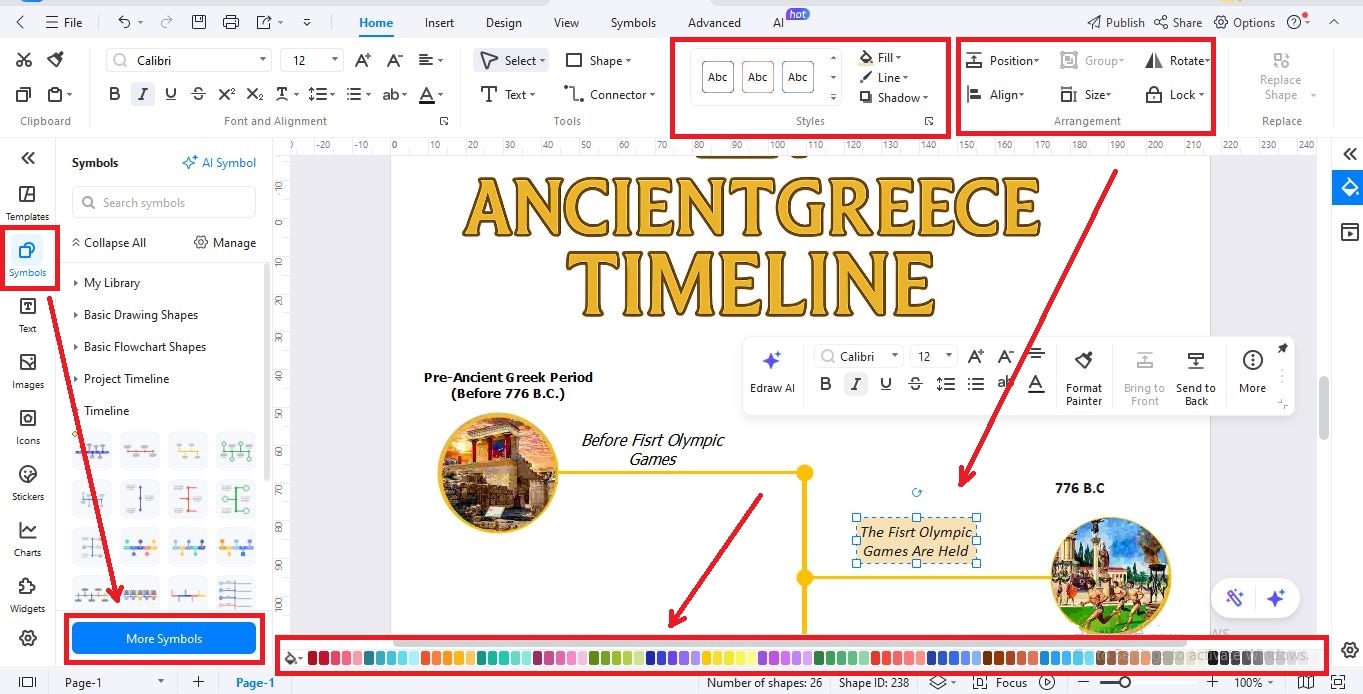
Step 6
- Go to the Insert tab and click Picture.
- You can upload an image from your computer, use EdrawMax's library, or paste one from Google.
- Once added, right-click and choose Send to Back so it sits behind your timeline.
- Lower the opacity to make it lighter from Adjust, and lock it with Move to Layer so it doesn't move by accident.
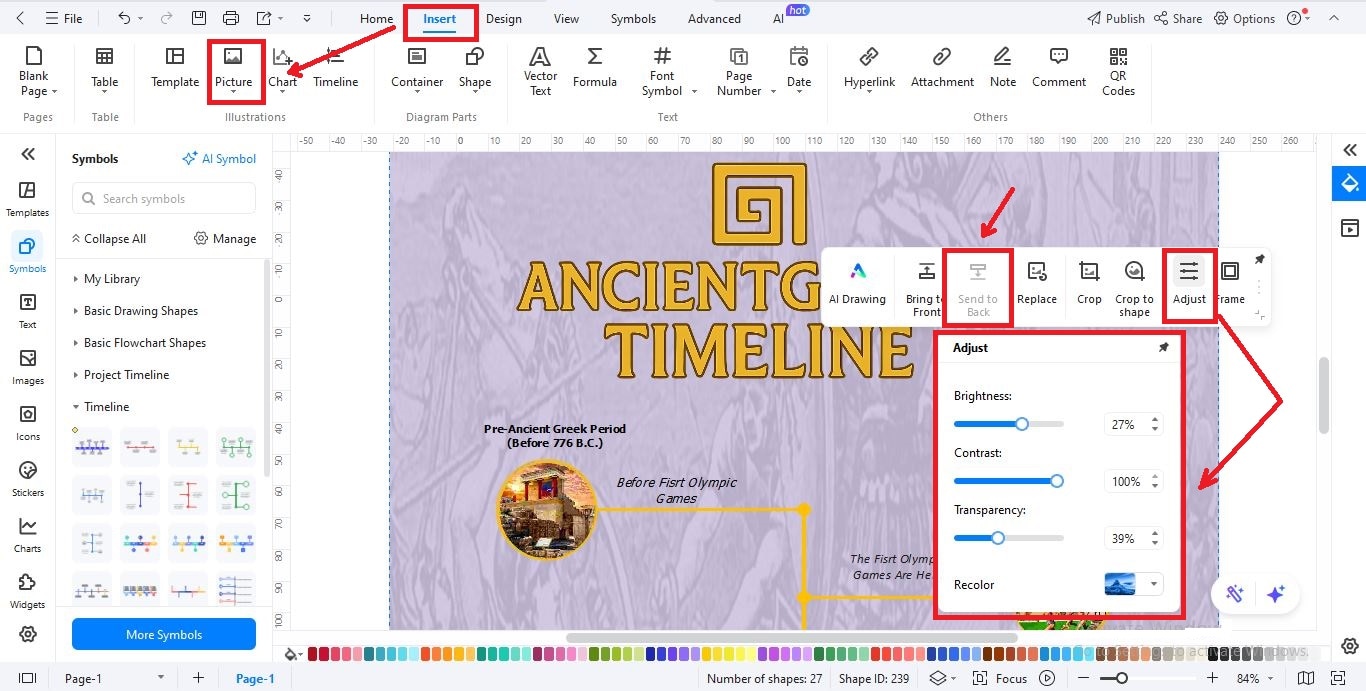
Step 7
- When you're done, click File > Save to keep an editable copy.
- To share your work, click Share in the top-right corner.
- If you want to export, go to File > Export and choose PNG, PDF, SVG, HTML, Visio, or Excel.
- To show your work to others, click Publish to post it in the EdrawMax community.
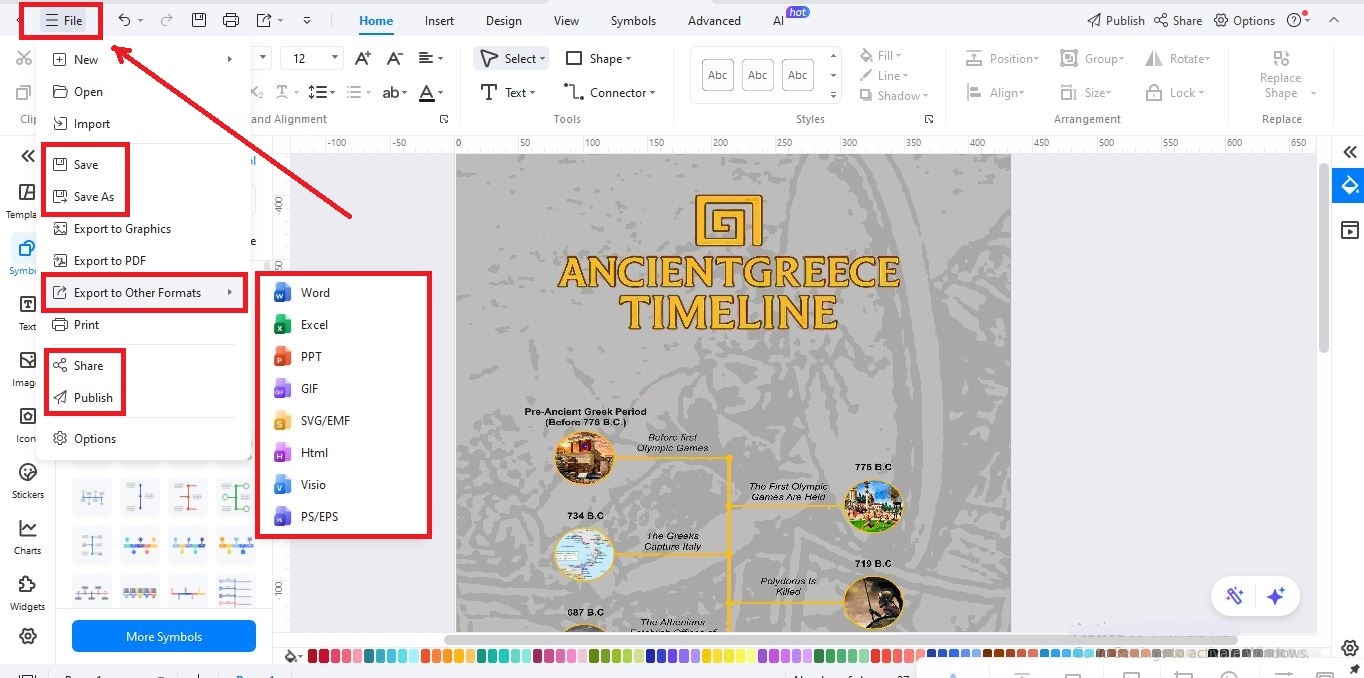
Closing Thoughts
Ancient Greece wasn't just about marble temples and famous battles. It was a place where ideas came alive. People gathered to debate, tell stories, and dream about the future. From the first Olympic Games to the birth of democracy, each moment built a world that still inspires us today.
Its philosophers shaped how we think. Its leaders and warriors shaped history. Even under Roman rule, the Greek spirit never faded. Want to explore it all? Use EdrawMax to create your own Ancient Greece timeline with ease and style.




